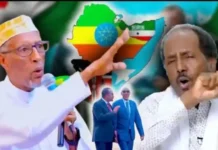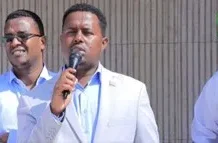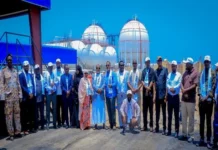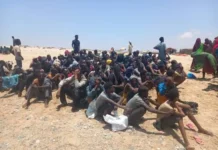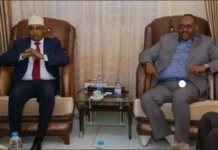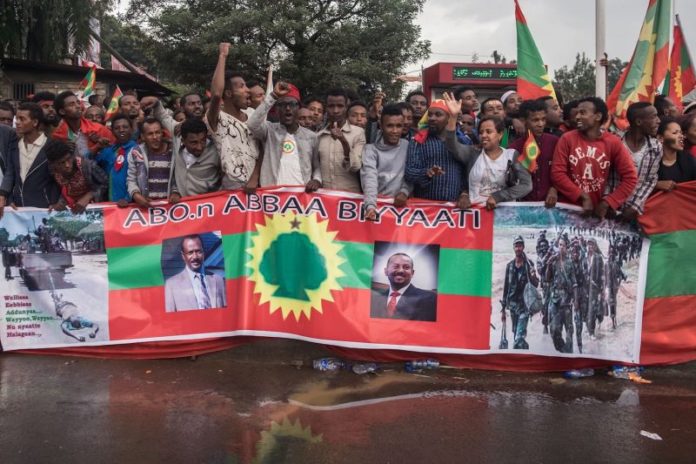
Within a few shorts months, Ethiopia has witnessed a dramatic transformation. The new prime minister, Abiy Ahmed, signed a peace agreement with Eritrea after years of simmering tensions. He has also granted pardons and amnesties to thousands of individuals and organizations once branded terrorists; all opposition groups based in Ethiopia or elsewhere have been invited to join in a peaceful transformation; media organizations are able to report more freely; legal reform councils and working groups have been established to review laws that were instrumental in the suppression of civil and political rights; and half of the prime minister’s cabinet is made up of women.
This unprecedented and rapid change comes against a more disconcerting backdrop of unrest. Ethiopia is a multiethnic giant with around 100 million people (belonging to more than 80 ethnic groups and speaking many languages), giving its transformation greater regional significance.
But there is also a risk. In this transformation, ethnic conflicts might increase in intensity and number, both as a result of a backlash by conservative forces rejecting the rapid reforms or due to the sudden liberalization of the public space.
Indeed, Ethiopia’s political system today has strong parallels with that of Yugoslavia in the 1990s.
ETHIOPIA’S POLITICAL SYSTEM TODAY HAS STRONG PARALLELS WITH THAT OF YUGOSLAVIA IN THE 1990S.
Similar to the former Yugoslavia, Ethiopia is a federal state with nine units organized along ethnic lines: The Tigray, Somali, Amhara, and Oromia regions (around 80 percent of Ethiopia) take their names from the dominant ethnic groups.
Empowering ethnic groups through territorial autonomy has been a double-edged sword: While allowing self-government has reduced tensions stemming from the dominance of a particular group, it places ethnic belonging at the center of politics, links it to territory, and therefore risks an eventual increase in ethnic tensions.
Yugoslavia was dominated by the multinational League of Communists, which had become a de facto confederation of republican parties by 1990. Likewise, Ethiopia has been ruled for decades by the Ethiopian People’s Revolutionary Democratic Front (EPRDF), a coalition of mostly ethnoregional political parties, dominated by the socialist Tigray People’s Liberation Front (TPLF). Both combined nondemocratic traits with ethnofederalism.
Yugoslavia experienced political transformation in the late 1980s, just as Ethiopia is today. Now, as then, questions about the future political and economic system have come to the fore, and power struggles are being overlaid with ethnic politics.
Conservative groups—whether the military and its allies among the Serb leadership in the old Yugoslavia or the long-dominant TPLF and its military and intelligence allies in Ethiopia—stand to lose the most from democratic transformation.
While it may appear that there is little reason for fear at the moment, secessionist claims of small groups in the Ethiopian Somali region have been around for decades, making the area a conflict zone until recently. The Tigray region could spark a crisis, too.
Some might consider this risk illusory, owing to the regions’ entrenched stake in a unitary Ethiopian state, regional authorities are making implicit threats of secession and even denying access to the region for federal law enforcement, as well as providing safe haven for individuals suspected of crimes against humanity and corruption.
Without careful management of the delicate transition, Ethiopia risks a dangerous fragmentation along ethnic lines.
WITHOUT CAREFUL MANAGEMENT OF THE DELICATE TRANSITION, ETHIOPIA RISKS A DANGEROUS FRAGMENTATION ALONG ETHNIC LINES.
After the death of Josip Broz Tito, the towering president for life, in 1980, the League of Communists relaxed its rule in large parts of Yugoslavia, leading to great media freedom, public debates, and economic reforms—but also rising nationalism.
As the ruling party could not resort to repression and as the views within the party in different units of the country diverged, nationalism became more prevalent. Controversies erupted among intellectuals and politicians from the richer north and poorer south, while war crimes committed during World War II became an increasing source of contentious debates.
Earlier, Tito and the party had imposed their narrative and branded all critics Nazi collaborators. Unlike in the Soviet Union, where opponents were exiled or killed, much of the repression in Yugoslavia was more subtle and succeeded without resorting to gulags. As these memories weren’t subject to public debate until the 1980s, they constituted a potent resource for nationalists, in particular to blame other ethnonational groups within Yugoslavia.
The path to violent dissolution was set during the years preceding it as political elites sought to gain power by taking advantage of the ethnofederal structure of the country.
THE PATH TO VIOLENT DISSOLUTION WAS SET DURING THE YEARS PRECEDING IT AS POLITICAL ELITES SOUGHT TO GAIN POWER BY TAKING ADVANTAGE OF THE ETHNOFEDERAL STRUCTURE OF THE COUNTRY.
The Yugoslav federation was divided into republics and two provinces, most of which had a dominant ethnonational group (save Bosnia and Vojvodina). Thus, nationalists could easily capture the republics, leading to secession, ethnic cleansing, and war.
Interest and support for Yugoslavia waned as the Cold War was winding down, leading to international disinterest until it was too late. In addition, the policies of the World Bank and International Monetary Fund increased tensions in Yugoslavia as they demanded austerity and a centralized economic policy, which ignored internal political dynamics and fueled social unrest. An ensuing economic crisis resulted in rising unemployment and shortages that undermined confidence in the Yugoslav state.
The absence of a unifying elite and leader—and the collapse of unifying ideas and institutions—accelerated the descent to violence. Political and social grievances were redirected by skillful politicians, not least by the rising star of Serbian communists, Slobodan Milosevic, against other ethnonational groups, particularly Albanians in Kosovo.
The Yugoslav scenario is not destined to repeat in Ethiopia, but it offers a cautionary tale: During moments of political liberalization, ethnonational federal systems are particularly combustible.
THE YUGOSLAV SCENARIO IS NOT DESTINED TO REPEAT IN ETHIOPIA, BUT IT OFFERS A CAUTIONARY TALE: DURING MOMENTS OF POLITICAL LIBERALIZATION, ETHNONATIONAL FEDERAL SYSTEMS ARE PARTICULARLY COMBUSTIBLE.
Some differences work in Ethiopia’s favor. First, the units of the Ethiopian federation did not previously exist as separate states. Second, loyalty to the Ethiopian state irrespective of ethnic or national allegiance and identification is strong. (Even the few extreme nationalists, such as the Oromo Liberation Front, are generally reacting to rampant injustice in the past rather than challenging the existence of the state.) Third, the bond among nationalities appears stronger. After all, all groups remember the common struggle against the Italian invasion more than 80 years ago, whereas in Yugoslavia the resistance against Nazi occupation was not universal; there were internal divisions between the resistance and collaborators. Finally, separation and secession appear impossible in key cases. For example, Oromia is the geopolitical center of Ethiopia; the secession of the country’s largest region is geographically impossible without a complete dissolution of Ethiopia (unlike in Yugoslavia, where the main claimants for secession had borders with other countries).
In Yugoslavia, the Serbian League of Communists in the late 1980s and early 1990s advocated centralization and keeping the country together, including by force, whereas parties in Slovenia and later Croatia advocated secession. In Ethiopia, there has been a turnaround as political parties that used to anchor their political agenda with demands for self-determination and sometimes secession, a constitutional right enshrined in Ethiopia’s constitution, recently shifted to preaching Ethiopian unity.
The two largest parties in the EPRDF coalition—the Oromo Democratic Party and the Amhara Democratic Party, which represent more than 70 percent of Ethiopia, ruling the Oromia and Amhara regions and controlling the federal government—belong to this category. The Southern Nations, Nationalities, and Peoples’ Region, representing more than 20 percent of Ethiopia’s population, is also now committed to the unitary state.
Despite these safeguards against fragmentation, many hazards remain. Like the Croats and Slovenes in the old Yugoslavia, there are also Ethiopian groups, such as the current Tigray regional administration, threatening secession.
LIKE THE CROATS AND SLOVENES IN THE OLD YUGOSLAVIA, THERE ARE ALSO ETHIOPIAN GROUPS, SUCH AS THE CURRENT TIGRAY REGIONAL ADMINISTRATION, THREATENING SECESSION.
There is an implicit threat from the TPLF (ruling a region comprising less than 10 percent of the population), which had disproportionately dominated the political and economic scene for the last three decades, to hold on to power.
The TPLF’s resentment includes selective criminal prosecution of its past and current officials (mostly on grounds of extreme rights violations of political dissidents and corruption) and discrimination and displacement of its people in federal and other regional administrations.
The process of liberalizing a political system in an ethnically polarized society is dangerous. During the liberalizing moment, newfound freedom of speech can easily focus on finding culprits, singling out particular groups, and bringing up repressed grievances. Furthermore, there is less tradition to distinguish fact from rumor, and thus fearmongering rhetoric can travel quickly and with fewer checks than in established pluralist environments. This is mostly due to social media but also because of a lack of reliable institutions and structures to turn to in a country where institutions have been decimated by years of authoritarian rule.
In addition, in ethnic federations, political parties and movements are likely to organize along ethnic lines (as they are in Ethiopia). Ethnic parties usually maximize their support not by moderation but by polarization.
ETHNIC PARTIES USUALLY MAXIMIZE THEIR SUPPORT NOT BY MODERATION BUT BY POLARIZATION.
First, this allows them to convince their voters about an existential threat to their group that necessitates them to vote for ethnic parties. Second, cross-ethnic voting is difficult, as this requires a more elaborate program than simply fomenting fear. Ethnic parties thus reinforce their raison d’être.
In ethnic federal systems, institutional power, economic and social inequalities, and ethnic identity overlap can easily reinforce themselves. Thus, economic grievances or perceived or real privileges of certain groups lead to heightened tensions.
Unlike in Yugoslavia, Ethiopia’s transformation is taking place in a more positive international context. All major actors appear to support or at least are content with the transformation taking place. The United States has expressed its support for the process, as have European leaders. Support also came from China, the most important economic actor involved in major infrastructure development, with billions of dollars in grants and loans.
So far, Abiy appears to have the wide support of Ethiopians, from almost all groups, a feat that no leader has managed in recent Ethiopian history. Despite his base in an ethnonationalist party, his speeches and actions have embraced and galvanized Ethiopian nationalism and depicted the country as a home for all nationalities—as long as the state is just.
But his work is far from finished. Ethiopia is witnessing unprecedented internal displacements and ethnic conflicts. More than 2 million people have been displaced, owing to interethnic conflicts allegedly caused by the TPLF and its cronies losing their socio-economic and military dominance. Allegations of discriminatory practices by regional and local governments against individuals and groups belonging to other ethnicities are also major causes of concern. Worse, the federal and regional institutions have not yet built the capacity to address those challenges.
For a successful peaceful and democratic transition, the new administration needs the support of international actors. But most of all, the prime minister needs new blood in the bureaucracy
FOR A SUCCESSFUL PEACEFUL AND DEMOCRATIC TRANSITION, THE NEW ADMINISTRATION NEEDS THE SUPPORT OF INTERNATIONAL ACTORS. BUT MOST OF ALL, THE PRIME MINISTER NEEDS NEW BLOOD IN THE BUREAUCRACY
—with commitment, diligence, and ability—to tame and reverse the rampant corruption, inequality, discrimination, mediocrity, and favoritism that were the hallmarks of the past regime.
To avoid the pitfalls Yugoslavia experienced, Ethiopia’s leaders need to address and defuse ethnic tensions immediately. Many such conflicts arise and are escalated because of incitement. As in the case of Yugoslavia, such radicalization stems from officials dissatisfied by the transformation, who seek to build public support through the politics of fear, and those who see the ethnofederal units as potential building blocks for political careers based on ethnicity.
Challenging such divisive politics will require a clear effort by the federal state to mediate and manage conflicts and to remain a neutral arbiter. In addition, a positive and shared project of transformation can also help counteract ethnic tensions. Such leadership, neutral and legitimate federal structures, and a shared project were all lacking in Yugoslavia.
Ensuring fair treatment of everyone by federal and regional governments, equitable distribution of power and resources, and efficient administration of governmental bureaucracy at all levels would reduce the sense of injustice, exploitation, and deprivation that might have in the past tempted some actors to push for secession.
The dissolution of Yugoslavia and the subsequent wars stand a warning that the transformation of ethnofederal states with diverse and divided group identities poses particular risks. So far, Ethiopia’s transformation has avoided some of the pitfalls of the Yugoslav experience—whether it will stay that way will depend on avoiding the same mistakes.
The article was originally published in Foreign policy Magazine
Florian Bieber is a professor of Southeast European history and politics at the University of Graz, Austria, and has been a visiting professor at Addis Ababa University. @fbieber
Wondemagegn Tadesse Goshu is an assistant professor at Addis Ababa University’s College of Law and Governance Studies



